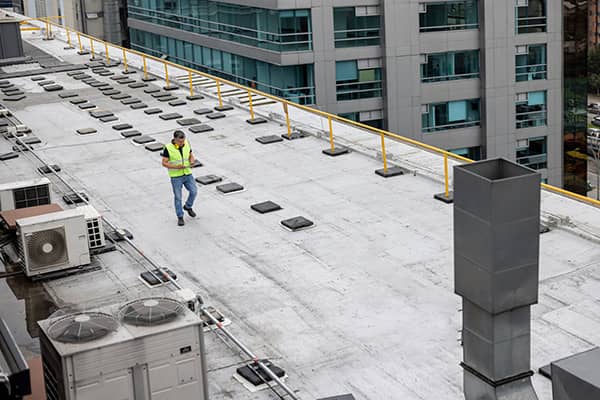Inspecting a commercial roof is a crucial aspect of its routine maintenance, vital for ensuring its durability and uncovering any potential problems lurking beneath the surface. Let’s go through the steps of inspecting a flat commercial roof, where safety and diligence are paramount.

Safety is always the #1 priority. Prioritize it above all else. Roofers equip themselves with the necessary gear: a safety harness, non-slip shoes, and a hard hat. If you’re not well-versed in roof inspections, it might be wise to enlist the services of a professional roofing contractor or inspector.
The weather sets the stage for inspections. Choose a day when the sky is clear and dry. This ensures both your safety and the accuracy of your observations.
Before you ascend to the roof, equip yourself with a set of tools and equipment: a notepad to record your findings, a camera or smartphone for photographic evidence, a trusty flashlight, a tape measure to gauge dimensions, a sturdy ladder to reach all corners, and a pry bar, ready to lift membrane edges if necessary.
Now, it’s time to set foot on the roof’s surface. Pay attention to every inch, seeking out any visible hints of damage, wear, or the pooling menace of ponding water. Pay heed to seams, flashing, drains, and penetrations such as vents or HVAC units. Look closely for cracks, blisters, bubbles, punctures, and any loose seams in the roofing material.
The roofing membrane, guarding against the elements, merits special attention. It can be single-ply, built-up, modified bitumen, or other materials. Examine it closely for signs of deterioration, like tears or holes. Keep an eye out for areas where the membrane might have lifted, distancing itself from the substrate. Don’t forget to inspect the seams and edges for any signs of separation or damage.
Flashing can be considered the unsung hero of roof protection. It wraps itself around roof edges, penetrations, and curbs. Verify that flashing is securely sealed and free of rust or corrosion. Note any loose or absent flashing components.
The heart of a good roof lies in its drainage system. Ensure that roof drains, scuppers, and gutters are free from debris and functioning as intended. Seek out any areas where water stands still, creating the condition known as ponding, which can expedite roof deterioration.
Examine the rooftop pipes, vents, and skylights. These can be vulnerable points for leaks, damage, or loose seals. Make sure that the sealants encasing these penetrations are in impeccable condition.
During the inspection, take pictures or video record any problems you encounter. Jot down detailed notes, specifying the location and severity of each issue.
If you have access to maintenance records for the roof, check them out as well. These may indicate recurring issues or prior repairs.
Now that you have your inspection findings, it’s time to take action. Schedule any necessary repairs or maintenance to rectify the issues you’ve uncovered. For tasks beyond your expertise, it’s prudent to seek guidance from a professional roofing contractor.
Lastly, develop a maintenance plan for your roof. This blueprint should encompass regular inspections and proactive measures to prolong its life.
In conclusion, remember that routine roof inspections are necessary for your roof’s longevity and your wallet’s well-being. If you’re not confident in your ability to conduct a thorough inspection, contact USA Premier Roofing today to safeguard your roof for many years to come.
